Tangram City
- Designer: Uwe Rosenberg
- Publisher: Capstone Games / Korea Board Games
- Players: 1-5
- Age: 8+
- Time: 30 minus
- Played with review copy provided by Capstone Games and OffDutyNinja
As a prestigious city planner, you have been ordered by the queen herself to build a harmonious city. Take care to balance the human and natural realms by creating equal amounts of building (black) and park (green) tiles, and do not forget to incorporate the shape of a rectangle — the shape most important for fortification. Can you build a city worthy of the queen? In Tangram City, players place tangram-shaped tiles in a randomly determined order in a square field while trying to balance the amount of building (black) and park (green) tiles. The more balanced these are and the more often you have built a rectangle shape, the more bonus points players receive.
Tangram City was honestly pretty high up on my list of games to check out at Spiel 2023 (and apparently high on the list of everyone else too). I made an appointment with the great folks at Korea Board Games, but unfortunately, by the time that I made that appointment on Friday afternoon, ALL THE COPIES were sold out. As with many super popular games at the fair, it usually is only a matter of time before a distribution deal is worked out – and lo and behold, here is an English/US version from Capstone within months…
Each player gets their own identical set of 23 tiles (be sure to follow the directions when punching the game to sort the bits immediately to prevent confusion and extra work!) and six fountain tiles. Players also get a city board and one green balance marker and one black balance marker. The deck of 23 cards is shuffled and placed on the table.
The game is played over five regular rounds and a special finishing round.
In each of the regular rounds, 4 cards are dealt out to start the hand – with the pattern for who gets cards in their hand, who shares cards in their hand and what cards go on the table (again face up or face down) spelled out in the rules; it’s different for each player count. Players should also note that each board has a different starting piece pre-printed on the board, and it is green on one side and black on the other. In this way, all players will end up with a different result at the end of the game.
The faceup card on the table is always played first. Then, if there are any facedown cards on the table, they go next. Then, going from the Starting player, the remaining cards are played. Each time a card is played, it is revealed and then ALL players choose the corresponding tile from their supply and play it on their boards. Note that some cards have yellow exclamation mark symbols on them – this warns you that there is at least one visibly similar tile, and you should make sure that you pick the correct tile! Once all four cards have been placed for the round, all players now take a fountain tile and place it legally on the board.
When you place a tile, it must go on an empty square, and you can flip and rotate the tile as you like before placement. Once on the board, they may not be moved. It is possible to forgo tile placement, but if you choose to pass on a tile, you will never have an opportunity to use it later in the game.
The round is now scored. Players find their largest fully built rectangle on the board, and then score the area of that rectangle. I.e. a 2 x 5 rectangle would score 10 points. Now, calculate your Green and Black balance. Look at your board and count the number of squares which are fully Green and fully Black. Fountains have no color, so a square that is half green and half fountain counts as all green. Move the Balance markers on your player board to match the current situation on your board. To end the round, the four cards used in the round are discarded and the start player token moves to the player with the highest score. If there is a tie, it goes to the next clockwise player tied for highest score from the current start player.
After five rounds as above, there is a special finishing round. In this final round, the final three cards are revealed and all players can place the final three tiles in any order they wish. After these tiles are placed, the final fountain tile is placed as well. There is one final scoring round as usual, and the final measurement of Green and Black balance is made.
The game ends with some end-game scoring.
If a player has fully filled in the 7×7 grid, they score 15 bonus points.
Players score up to 20 points based on how well the green and black are balanced on their board.
The player with the highest score wins. There is no tiebreaker.
My thoughts on the game
Tangram City is the sort of game that I tend to gravitate to – it gives you an interesting puzzle to solve, and you’re left on your own for much of the game. As I play this, I get to concentrate on the puzzle in front of me and work out the best way to place my pieces. The two big goals are making the biggest rectangle I can make and balancing out the green/black situation.
While players do NOT play the same game, it is definitely a solitaire situation. There really isn’t anything that your opponents can do to affect your tile choice, and you’re not in competition with them for anything other than the final score. You could be in the same room, you could be playing by mail/Zoom/email – your experience is pretty much the same. There are no intermediate goal cards which might make you want to play your tiles in a different manner from game to game – the game trajectory here will always be the same.
Where the game will be different is in which piece of hidden information is yours to see each turn. Players are given access to one card each round that can help them plan out their turn. There is a bit of a balancing mechanic in that the current high scorer is the Starting Player, and their card is revealed first – meaning that all the other players will have more time to use their hidden information to plan their turns out. This fails a bit (IMHO) as a catch up mechanism though because play then goes clockwise; if you’re in last place but next clockwise from the start player, you end up with the second worst turn for planning, and that likely won’t help you as much. If the cards were revealed in descending current score, it would maybe be a bit better for me – but YMMV.
Depending on who you play with, your game might be slow. There is a LOT to think about each turn, and after the midway point of the game, lots of calculating and mental placing of tiles. I have found that the sticking point seems to be the constant fight for green/black balance which requires a lot of counting. To ease this, remind players to update their green/black markers on their player board which should help.
There are a lot of points available due to balance, and this is something that should not be ignored. Despite having a nice bonus for fully filling in the board, I have seen a full board lose to someone who had perfect balance and a smaller finishing rectangle.
The components are fine, and if you follow the directions in the box, and bag everything as you punch it, you’ll save yourself a lot of time and confusion later. I will note that there is one weird piece that oftentimes looks like it doesn’t fit in the grid. Most of the pieces can be rotated 90 degrees and fit in any orientation, but there is one piece that must go in a particular orientation – I always make a point to pull this piece out and show it to people as I teach.
One other thing to note is that the new EN version does have one change from the original – the original version had red/green balance, and that was an issue for red-green color blind people. The coloring has been changed to now be green/black. I’ll admit that it’s still not super easy to see the colors, and the fountains could be a bit more distinct – but I do like the fact that effort was made to increase playability. So kudos to whoever caught that and made the change.
If you are someone who doesn’t mind a simultaneous solitaire game, this is a really thinky puzzler that is worth trying. It doesn’t offer anything new in the mechanic sense, but the new puzzle here is a challenge to solve each game. The random order of the tiles coming out makes each game play differently as you try to fill up your board efficiently and as completely as possible. As I’ve found from playing with different people, if you want more interaction in your game, this is definitely not one for you. If you like solo puzzles, this one is great for setting up and playing at your own speed (I have done it on the desk at work over the course of the day).
Thoughts from other Opinionated Gamers
.
Joe Huber (4 plays): I hadn’t heard of Tangram City prior to Essen, but seeing the booth right next to Bezier Games’ booth, it intrigued me – and I picked up a copy. On the first play, I enjoyed it. And on the second. But on the third something was feeling a bit off; on the fourth I knew that it wasn’t a game for me. The biggest problem is that the game is best played by, as tiles come up, finding both the optimal short-term play of the tile and then solving for filling the board. This is, for humans, a naturally slow task – and, at least for me, constraint solving isn’t something to do for the fun of it.* I couldn’t stop myself from doing it, so it’s a game I won’t play again. But, unlike most games I won’t play again, this one did bring me joy before reaching that point, and so I rate it as Neutral, rather than Not for me.
* – Over twenty years ago I was part of a class for work which included an exercise where a group of folks would try to create a piece of music to meet various requirements. Some folks were given the requirements, some were given the musical options, and so on. Team building. Except – once I realized how things worked, I was driven to solve the third puzzle, which we would be doing after lunch. I spent the whole lunch period working on a near-optimal solution for the third puzzle, blowing off the instructor who wanted to take a picture of the team. It really wasn’t fun, though; it was just something I felt compelled to do.
Dan B. (several plays): I originally rated this “like it” but at this point I am dropping it to “neutral” because of what Joe describes, basically. Since you always play all the pieces, there’s always a way – probably many ways – to fill your board and perfectly balance the colors. The wrinkle is that you want to maximize your rectangle scorings along the way, so you can’t just memorize a perfect arrangement and make it, as that would likely result in small rectangles. So, as Joe says you have to play for the rectangles while making sure you can complete your board correctly. This leaves most people with the choice between taking far too long to analyze each turn and just winging it. I think this sort of game works much better when some pieces randomly don’t get played, so you can’t fully optimize things and have to decide how risky you want to be.
That being said, my rating is a high neutral as I’d be willing to play if someone wanted. I’d rather play Second Chance or Patchwork Doodle, however.
Ratings from the Opinionated Gamers
- I love it!
- I like it. Dale Y, Steph H
- Neutral. Joe H, Dan B,
- Not for me… Ryan P, Michael A


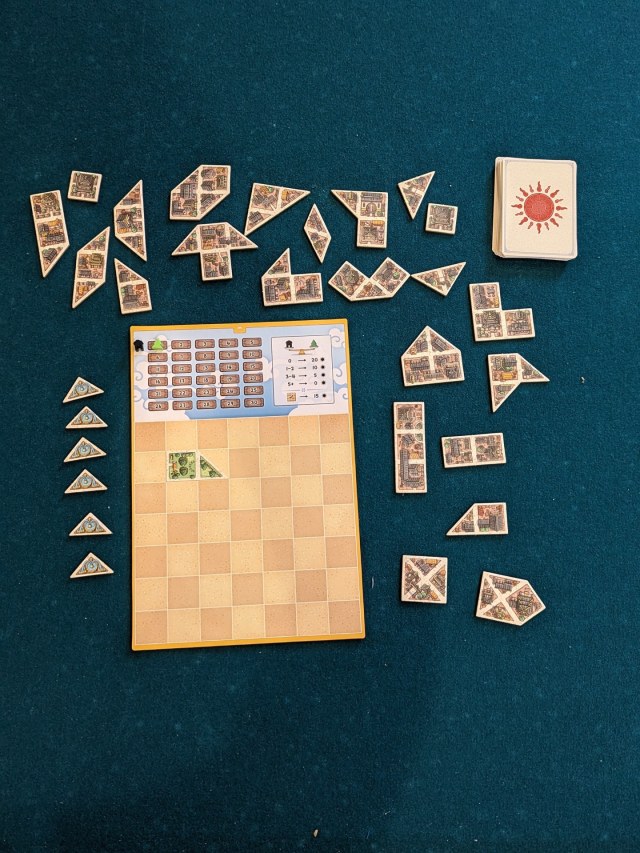

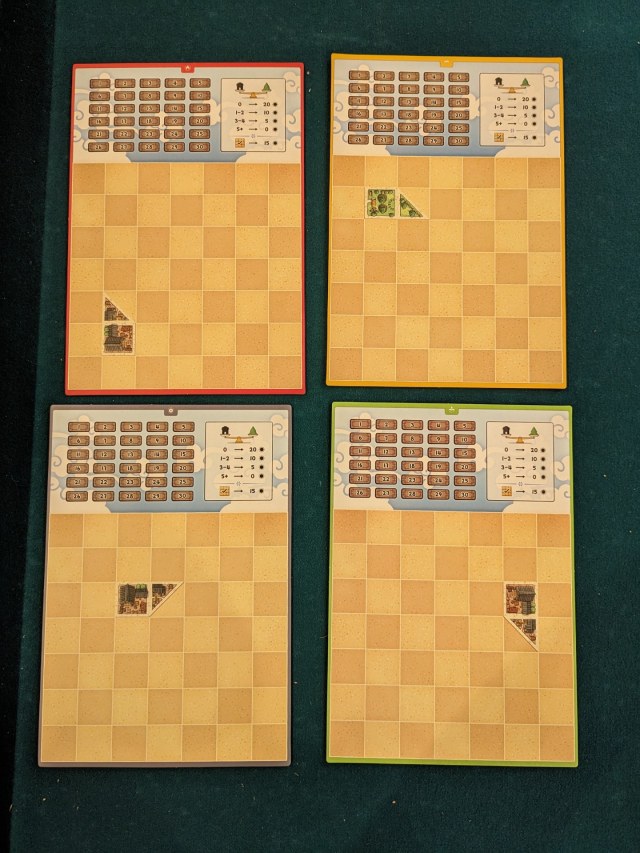
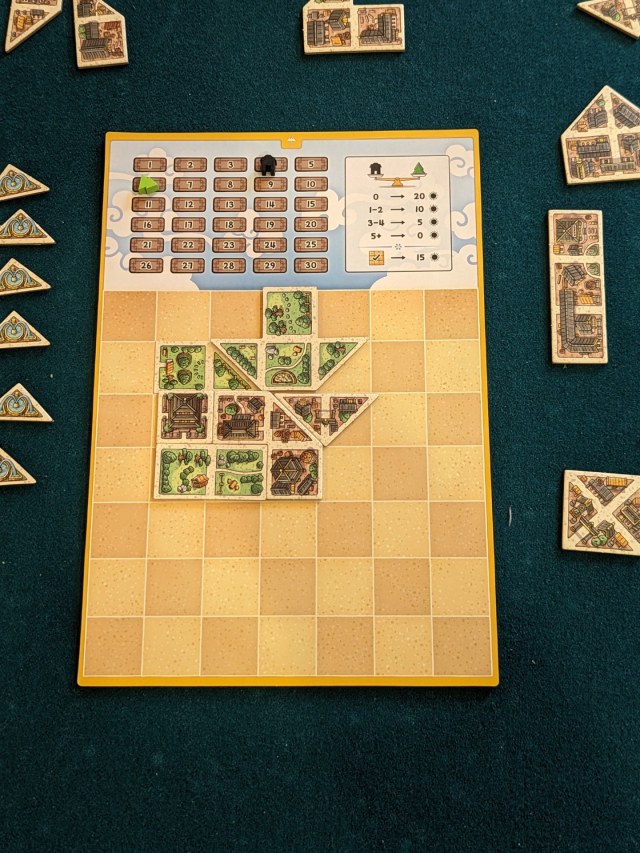
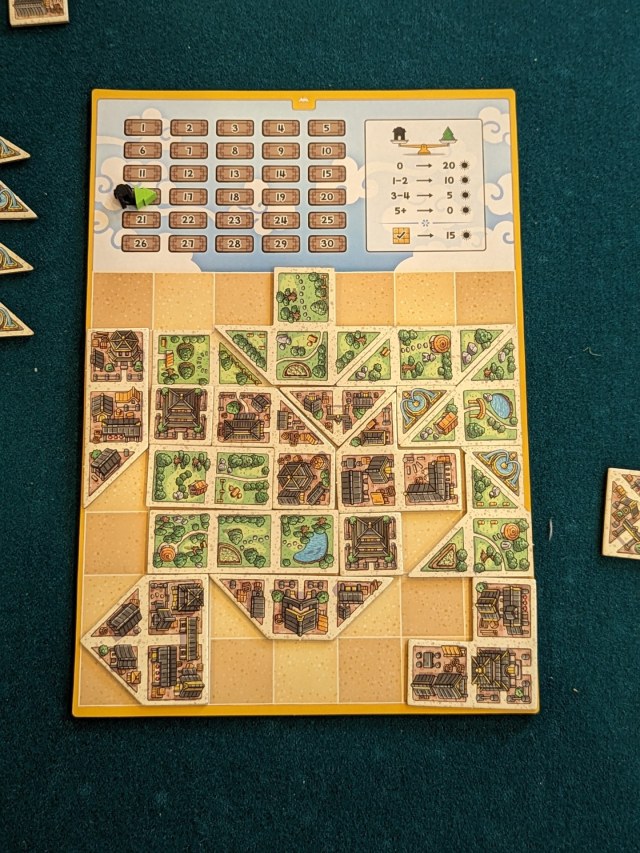

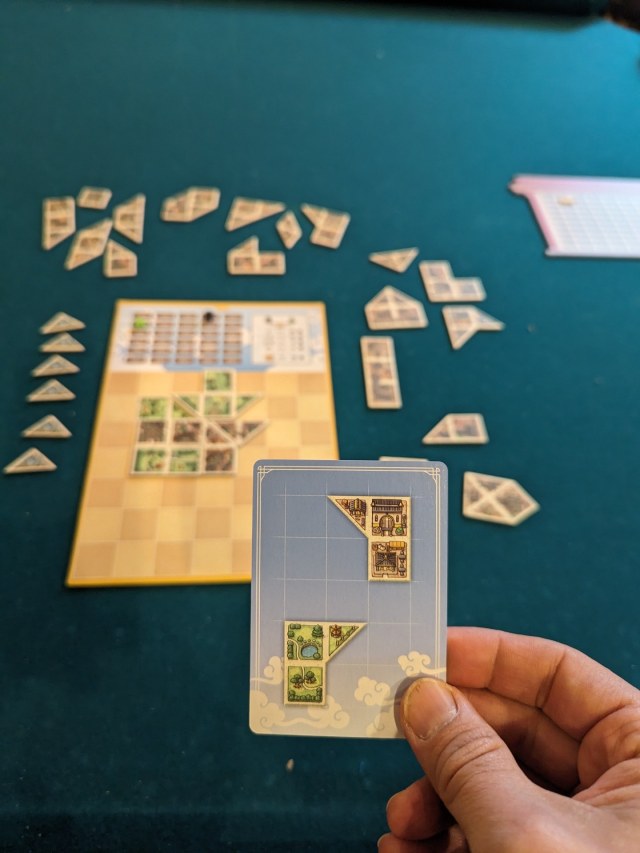
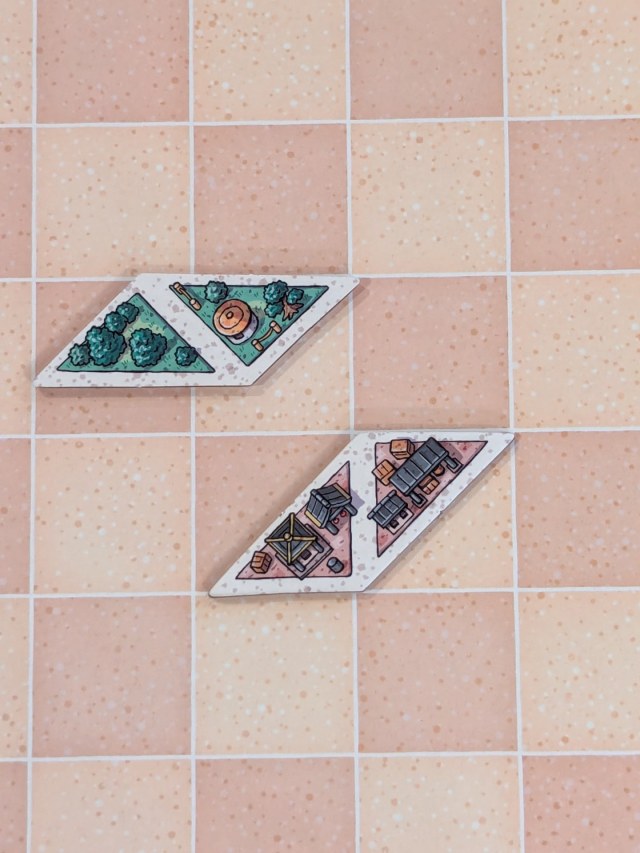
I’m not sure how you can resist singing “Take me down to Tanagram City… Where the grass is green and the tiles are pretty (take me home)” whilst playing the game. :-)